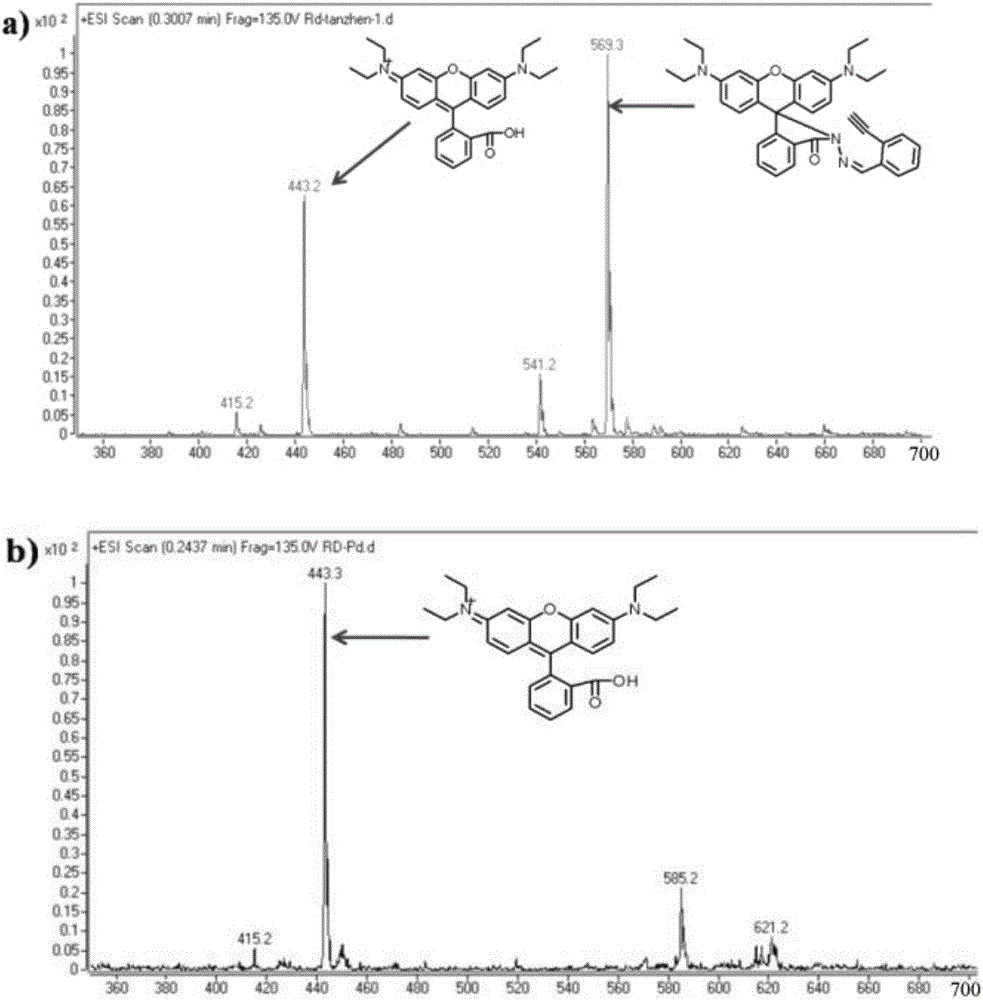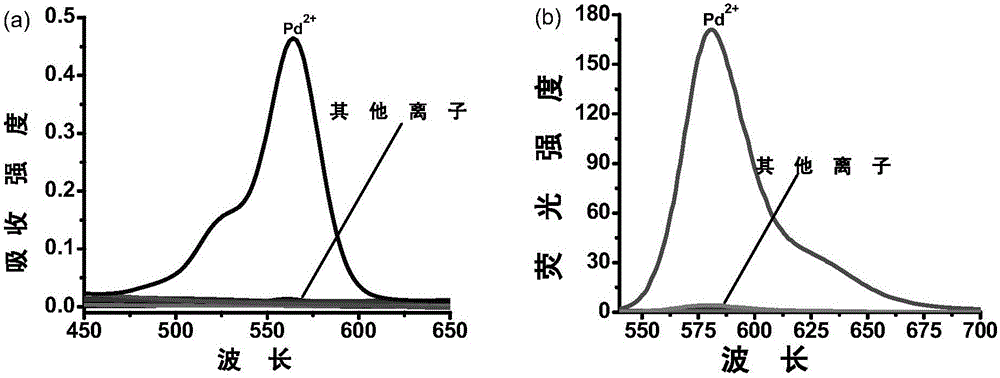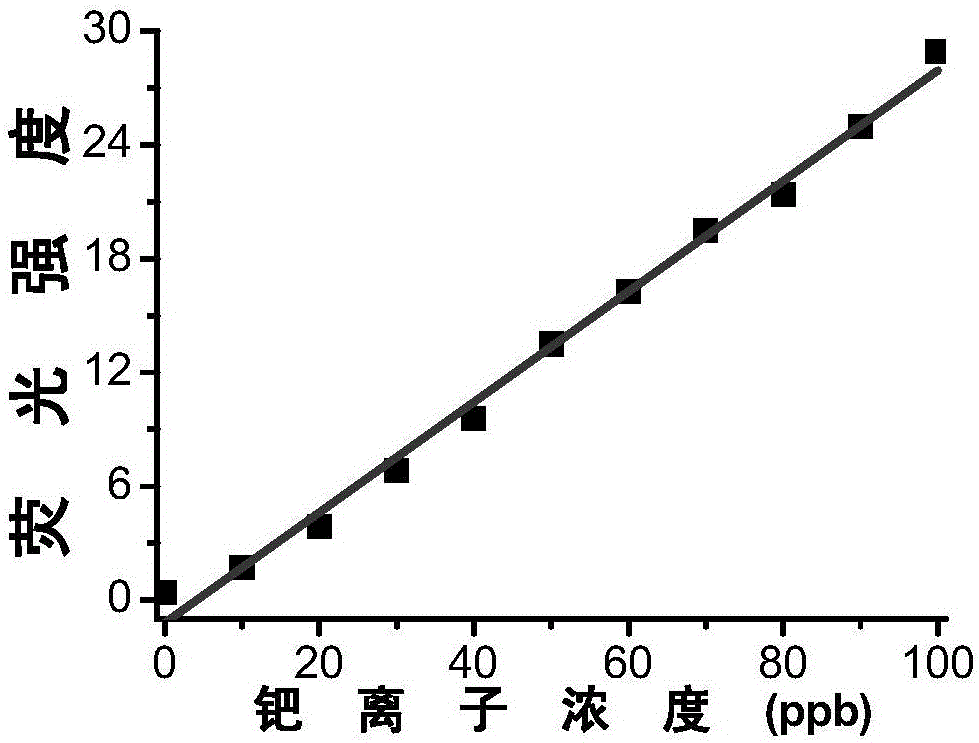Palladium ion fluorescent probe compound and application thereof
A fluorescent probe, palladium ion technology, used in fluorescence/phosphorescence, luminescent materials, organic chemistry, etc., can solve problems such as interfering probe specificity, and achieve excellent selectivity, good stability, and strong anti-interference ability. Effect
- Summary
- Abstract
- Description
- Claims
- Application Information
AI Technical Summary
Problems solved by technology
Method used
Image
Examples
Embodiment 1
[0024] The synthetic method of palladium ion fluorescent probe compound Rd-TP:
[0025]
[0026] (1) Synthesis of Intermediate A
[0027] Rhodamine B (1.2 g, 2.5 mmol) was added into a 100 ml single-necked flask filled with 30 ml of ethanol. Stir vigorously at room temperature, add 3ml of 80% hydrazine hydrate dropwise (excess), and reflux in air for 2h, the color of the solution changes from dark purple to light brown first, and finally to light pink. After cooling to room temperature, the ethanol was distilled off under reduced pressure. Then 50ml of hydrochloric acid (1M) was added to obtain a red solution; while stirring, 70ml of sodium hydroxide (1M) was added until the pH reached between 9 and 10, and a large amount of precipitation appeared. Filter and wash the filter cake 3 times with 15 ml of water. After vacuum drying, 0.63 g of the target product (Intermediate A) was obtained by column separation, with a yield of 55.2%. 1 H NMR (400MHz, CDCl 3)δ:1.15(t,12H),...
Embodiment 2
[0031] The selectivity of embodiment 2 palladium ion fluorescent probe compound RD-TP to palladium ion:
[0032] Add metal cations at a concentration of 40 μM to 10 μm of palladium ion fluorescent probe compound Rd-TP, ethanol and water (EtOH:H 2 O=1:1, volume ratio) solution, the selected metal cations are: K + ,Na+,Ag+,NH 4 + , Ca 2+ ,Mg 2+ ,Zn 2+ ,Cd 2+ , Ba 2+ ,Pb 2+ ,Cu 2+ ,Hg 2+ ,Mn 2+ , Ni 2+ ,Co 2+ ,Pt 2+ Fe 3+ ,Cr 3+ , Rh 3+ and Ru 3+ . The result is as figure 1 As shown, during the 10-minute standing process, the palladium ion fluorescent probe compound Rd-TP has no absorption and fluorescence changes for various cations. Only when palladium ions exist, the absorption and fluorescence show obvious enhancement changes. Therefore, the palladium ion fluorescent probe compound Rd-TP of the present invention has good selectivity and no selectivity to other cations.
Embodiment 3
[0033] Example 3 Sensitivity test of palladium ion fluorescent probe compound Rd-TP to palladium ion:
[0034] The palladium ion concentration of ppb level is tested by using the palladium ion fluorescent probe compound Rd-TP of the present invention. The palladium ion fluorescent probe compound Rd-TP (10 μm) was added to ethanol and water (EtOH:H 2 O=1:1, volume ratio) solution, record the corresponding fluorescence intensity changes, the results are as follows figure 2 shown, from figure 2 It can be seen that the palladium ion fluorescent probe compound Rd-TP has an obvious intensity change in the palladium ion at a concentration of 0-100ppb, and this intensity change has a good linear relationship with the concentration of the added palladium ion. This result shows that the palladium ion fluorescent probe compound Rd-TP can be used at very low concentration.
PUM
 Login to View More
Login to View More Abstract
Description
Claims
Application Information
 Login to View More
Login to View More - R&D Engineer
- R&D Manager
- IP Professional
- Industry Leading Data Capabilities
- Powerful AI technology
- Patent DNA Extraction
Browse by: Latest US Patents, China's latest patents, Technical Efficacy Thesaurus, Application Domain, Technology Topic, Popular Technical Reports.
© 2024 PatSnap. All rights reserved.Legal|Privacy policy|Modern Slavery Act Transparency Statement|Sitemap|About US| Contact US: help@patsnap.com










